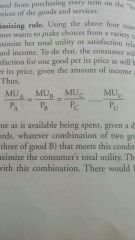![]()
![]()
![]()
Use LEFT and RIGHT arrow keys to navigate between flashcards;
Use UP and DOWN arrow keys to flip the card;
H to show hint;
A reads text to speech;
44 Cards in this Set
- Front
- Back
|
Market |
Place where buyers and sellers need to exchange goods and services. |
|
|
Quantity Demanded |
Has an inverse relationship with changes in the price of a particular good. |
|
|
Quantity Supplied |
Has a direct relationship with changes in the price of a particular good. |
|
|
Changes in Demand (Supply) |
Shift in demand (supply) due to non price factors |
|
|
Normal Goods |
Goods whose consumption increases as income increases. |
|
|
Inferior Goods |
Good whose consumption decreases as income increases. |
|
|
Giffen Goods |
Good for which there is an upward-sloping demand curve (theoretical) |
|
|
Ceteris Paribus |
Holding all other factors or conditions constant. |
|
|
Price Elasticity of Demand Formula |
% Change in Quantity Demanded/% Change in Price |
|
|
Cross Price Elasticity of Demand |
%Change in Quantity Demanded of Product Y/ %Change in Price of Product X |
|
|
Income Elasticity of Demand |
%Change in Consumption of a Good/ %Change in Consumer Income |
|
|
Price Elasticity of Supply |
%Change in Quantity Supplied/ %Change in Price |
|
|
Utility-Maximizing Rule |

|
|
|
Total Utility |
The total satisfaction a consumer receives from the consumption of a good or service. |
|
|
Diminishing Marginal Utility |
At some point in the consumption pattern of a good, each additional unit consumed yields less addition satisfaction (utility) |
|
|
Income Effect |
As the price of a particular good decreases, a consumer can afford more of it and other goods. |
|
|
Substitution Effect |
As the price of a particular good decreases, a consumer may buy more of this good relative to the price of a substitute good. |
|
|
Consumer Surplus |
The difference between the utility gained and the price paid by the consumer. The utility gained would measure the value of the product to the consumer. The price paid by the consumer would be the market price. |
|
|
Pure Private Good |
A good that has exclusion and distributive characteristics. |
|
|
Technological Efficiency |
The identification of those inputs that have the greatest effect on output per dollar of input expenditure. |
|
|
Pareto Efficiency |
The optimal point for society when any further improvement for some comes at the expense of others. |
|
|
Pure Public Good |
Goods which have non exclusion and non distributive characteristics. |
|
|
Quasi-Public Goods |
Goods which have some limited private good characteristics such as congestible public goods and price excludable public goods. |
|
|
Law of Diminishing Marginal Productivity |
The range of output over which smaller and smaller additional units of output are produced as successive equal increments of a variable input are added to fixed quantities of other inputs in the short run. |
|
|
Economies of Scale |
Savings per unit costs of productive as output increases. |
|
|
Economic Profits |
Income or revenue minus explicit and implicit costs. |
|
|
Accounting Profits |
Income or revenue minus explicit costs. |
|
|
List the Determinants of Demand |
- Consumer tastes and preferences - Related goods' prices - Income of consumers - Number of buyers in the market - Expectations for future price |
|
|
List the Determinants of Supply |
- Resource cost - Other goods prices - Technology - Taxes and Subsidies - Expectations of future prices - Number of producers |
|
|
Profit Maximizing Criterion |
The level of output at which marginal revenue (MR) equals marginal cost (MC). |
|
|
Herfindahl Index |
The sum of the squares of market shares of firms in a particular market or industry; used to measure the level of concentrated power of firms in an industry. |
|
|
Natural Monopolies |
These are monopolies for which competition would prevent the benefits of economies of scale. |
|
|
Monopolistic Competition |
This form market structure is characterized by many medium sized firms that need to innovate and differentiate their products in both price and nonprice competition. |
|
|
Oligopoly |
This form of market structure is characterized by relatively few sellers who act interdependently and/or collusively to be price makers. There are strong barriers to entry and exit. |
|
|
Inefficiency |
This is the expected outcome of monopolistic competition derived from underutilizing capacity. |
|
|
Derived Demand |
The demand for resources such as labor is derived from the product that the resource helps produce. |
|
|
Wage Elasticity of Demand |
The percentage change in quantity demanded of labor in response to a percentage change in the wage rate. |
|
|
Marginal Revenue Product (MRP) |
The addition of the firm's revenue as the result of an additional output for an additional unit of labor. |
|
|
Marginal Factor Cost |
The additional cost for each additional unit of labor hired. |
|
|
Marginal Physical Product (MPP) |
The additional output produced as one more unit of labor (resource) is added. |
|
|
Monopsony |
A market in which there is a single buyer of labour. |
|
|
Human Capital |
The investment in people that increases their future monetary and psychic income. |
|
|
Lorenz Curve |
A curve that measures the degree of income inequality as contrasted with income equality. |
|
|
Arbitrage |
The practice of buying a good in one market and selling it for a higher price in another market. |

